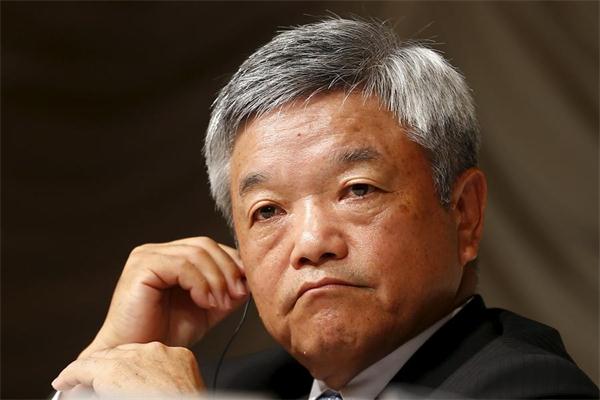FT deal a boost for Nikkei's media profile
Updated: 2015-08-03 08:07
By Jin Yong(China Daily)
|
||||||||
 |
|
Nikkei's President and CEO Naotoshi Okada attends a news conference in Tokyo July 24, 2015. Nikkei's $1.3 billion purchase of the Financial Times from Britain's Pearson PLC marks the culmination of decades of attempts by the Japanese household name to break into mainstream English-language media. [Photo/Agencies] |
Pearson PLC, the London-based multinational publishing and education company, announced on July 23 that it was selling the Financial Times Group to Japanese media company Nikkei for about $1.3 billion. It is the biggest overseas purchase by a Japanese media company, giving Nikkei the largest global readership of financial news.
As Asia's largest independent business media group, Nikkei has scored a decisive point in its competition with its domestic rivals Yomiuri Shimbun, Asahi Shimbun, Mainichi Shimbun and Sankei Shimbun. But this is not the first time that a Japanese company has acquired (or merged with) a major Western counterpart. Sony Corp purchased Hollywood's Columbia Pictures for about $4.8 billion in 1989, cementing its role as a global entertainment conglomerate.
Transnational mergers of media outlets are not new either. For instance, US media giant AOL Time Warner Inc. came into being after the merger of America Online and Time Warner in 2001, and Thomson Reuters is the result of the marriage between Canada's Thomson Corporation and the UK-based Reuters Group in 2008.
More business mergers will take place in the future, because that is the trend of globalization. Still, the way Nikkei beat other potential players such as German media giant Axel Springer to clinch the FT deal deserves special attention.
To begin with, the FT deal is in line with Nikkei's ambition of becoming a major part of the globalization process and a vital player in Japan's global media strategy. Because of the sluggish domestic economy and territorial disputes with China and the Republic of Korea in recent years, Japan is craving for a bigger say in mainstream Western journalism, which prefers English as the language of business.
As a British flagship financial newspaper with global reach, the pink FT is expected to help its new proprietor, especially The Nikkei, formerly known as Nihon Keizai Shimbun, the newspaper run by the Nikkei media group, to occupy a higher pedestal in the field of information at home and abroad.
Japanese media outlets, as a whole, have not been able to acquire a special place in global journalism because of their use of the Japanese language. But now Nikkei could become a leading Japanese media service provider in the West thanks to the extensive readership of the FT. For example, digital subscribers of The Nikkei newspaper will reportedly increase by more than 500,000 to about 930,000, exceeding the readership of The New York Times (more than 910,000 subscribers) and boost Nikkei's strength in domestic competition.
Pearson cannot be blamed for relinquishing the FT's ownership, which it has held since 1957, because it wants to focus on its burgeoning education business and Nikkei's $1.3 billion offer is fair in every respect despite the London-based newspaper's 127-year-old history, and unparalleled reputation and influence.
The biggest winner of all is The Nikkei newspaper, which for starters, will enjoy a significant rise in readership and subscription incomes. Also, given the authority of both the Nikkei Index and the FT Index, the Japanese media group will become a leader in financial news, reinforcing Japan's image as a major economy. The total circulation of the merged Nikkei could reach 3.5 million, nearly 2 million more than that of its major US rival The Wall Street Journal.
As for Chinese media companies, it is a pity that they did not compete to gain the ownership of the FT. Like the country's oil companies which focus more on transnational mergers, Chinese media companies, too, should be encouraged to acquire more international media outlets.
Moreover, to change the monotonous presentation of data and statistics, China's news providers should see the FT as their role model and try to match it in terms of timely reporting, setting agendas and talent recruitment.
The author is an associate professor with the Communication University of China.
- Global health entering new era: WHO chief
- Brazil's planning minister steps aside after recordings revelation
- Vietnam, US adopt joint statement on advancing comprehensive partnership
- European border closures 'inhumane': UN refugee agency
- Japan's foreign minister calls A-bombings extremely regrettable
- Fukushima impact unprecedented for oceans: US expert

 Stars of Lijiang River: Elderly brothers with white beards
Stars of Lijiang River: Elderly brothers with white beards
 Wealthy Chinese children paying money to learn British manners
Wealthy Chinese children paying money to learn British manners
 Military-style wedding: Fighter jets, grooms in dashing uniforms
Military-style wedding: Fighter jets, grooms in dashing uniforms
 Striking photos around the world: May 16 - May 22
Striking photos around the world: May 16 - May 22
 Robots help elderly in nursing home in east China
Robots help elderly in nursing home in east China
 Hanging in the air: Chongqing holds rescue drill
Hanging in the air: Chongqing holds rescue drill
 2.1-ton tofu finishes in two hours in central China
2.1-ton tofu finishes in two hours in central China
 Six things you may not know about Grain Buds
Six things you may not know about Grain Buds
Most Viewed
Editor's Picks

|

|

|

|

|

|
Today's Top News
Liang avoids jail in shooting death
China's finance minister addresses ratings downgrade
Duke alumni visit Chinese Embassy
Marriott unlikely to top Anbang offer for Starwood: Observers
Chinese biopharma debuts on Nasdaq
What ends Jeb Bush's White House hopes
Investigation for Nicolas's campaign
Will US-ASEAN meeting be good for region?
US Weekly

|

|







